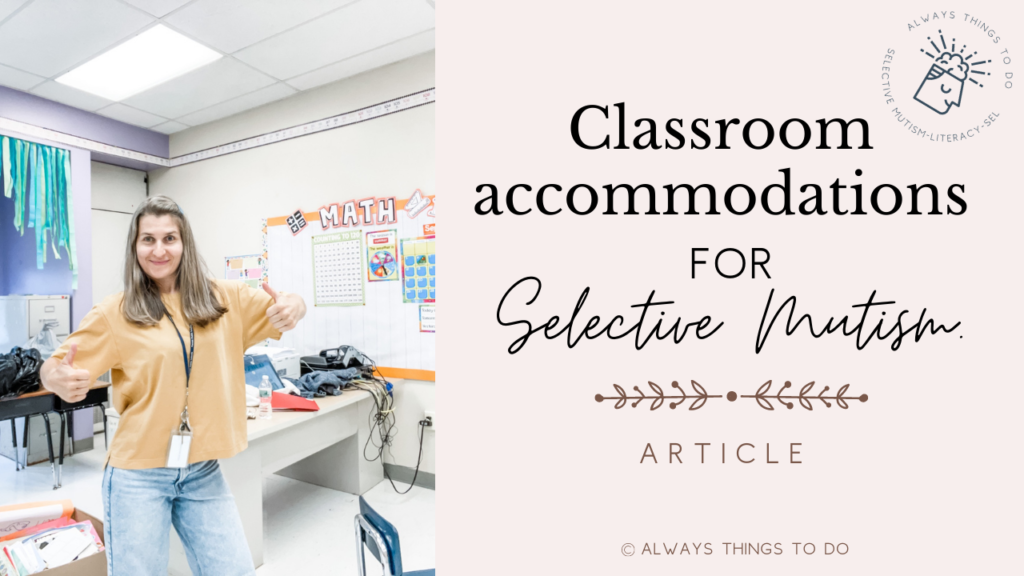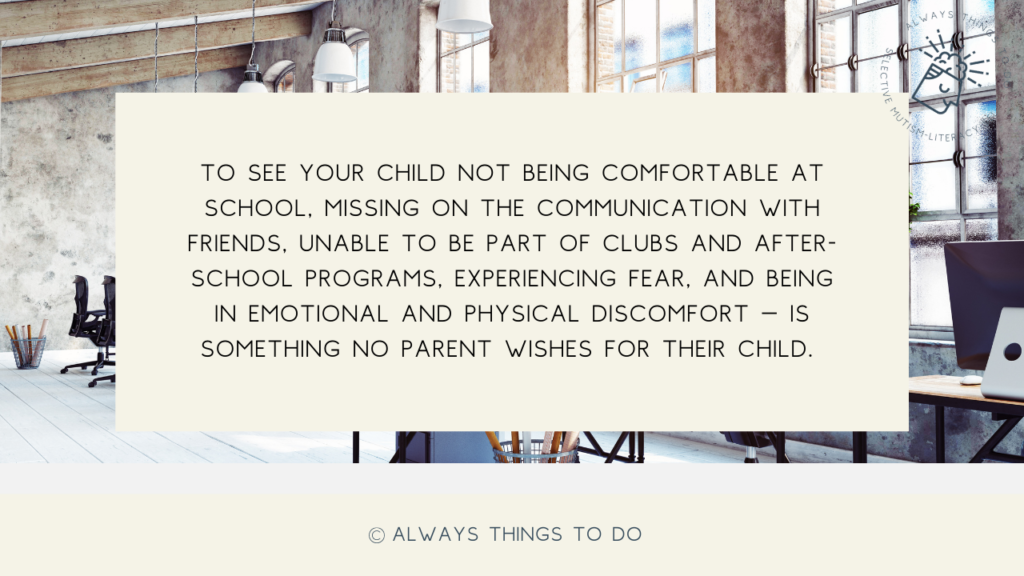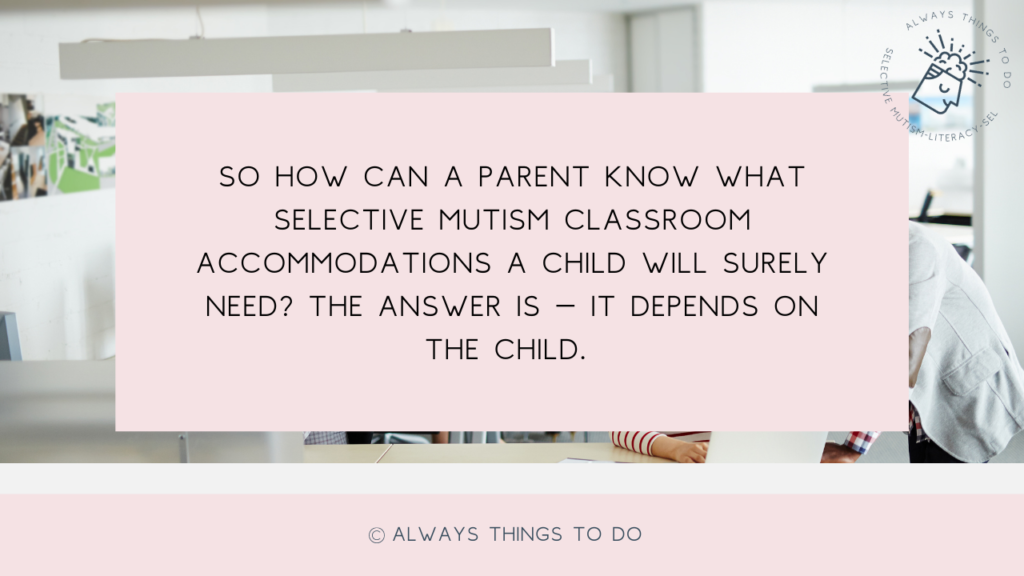Selective Mutism Classroom Accommodations: What You Need To Know About 504 and IEP.

In this post, you will learn about:
- Why you need an IEP or 504 plan to give your child the best selective mutism classroom accommodations.
- Which plan (504 or IEP) is best for selective mutism classroom accommodations.
- What parents need to know about IEP and 504.
- How to make selective mutism classroom accommodations actionable.
You need an IEP or 504 plan to give your child the best selective mutism classroom accommodations.
Selective mutism anxiety disorder impacts a child in many different areas:
- thinking
- remembering
- learning
- communicating
- hearing
- mental health
- social relationships
At home, the child with selective mutism experiences anxiety which manifests in many exhausting behaviors to both the child and the parents.
When the child transitions to school, the child’s functioning is even more restricted depending on the level of anxiety the child is having. Some of the areas and functioning of a child in a classroom impacted by the selective mutism anxiety disorder are:
- communication with teachers and peers
- expressing basic needs
- eating or drinking in front of others
- emotional distress from being “bottled up” most of the time in school
- self-esteem
- academic problems
- participation in after-school activities
As a mom of a child with selective mutism, I have learned about the impacts of selective mutism on my child first-hand.
To see your child not being comfortable at school, missing on the communication with friends, unable to be part of clubs and after-school programs, experiencing fear, and being in emotional and physical discomfort – is something no parent wishes for their child.
This is the reason why parents need to consider all the support systems that are available at the level of the school district.
Educating oneself about selective mutism and its impacts, researching the selective mutism classroom accommodations available to your child, and reaching out to the school district professionals to establish an intervention plan for the child is a must-do for every parent.
The IEP plan provided as part of a special education program at a school district may serve as a robust supporting system for a child with selective mutism. Therefore, parents need to learn about the services available to the child through the special education department in a school.
Which plan (IEP or 504) is the best for selective mutism classroom accommodations?
An IEP stands for Individualized Educational Program. Simply speaking, an IEP is a map that explains the program of special education instruction, support available to the child, and the services the child can have to show progress and thrive at school despite any disability, including selective mutism.
Unlike an IEP, the 504 plan can also provide accommodations for selective mutism to a child; however, the 504 plan is not part of special education.
In fact, there are many other subtle differences between the IEP and 504 plans that you can learn about here.
But what exactly do parents of a child with selective mutism need to know about 504 and IEP?
First, when the child’s study team evaluates the child’s eligibility for special education services, the IEP might not be something the child will receive.
Depending on the school district, a child might start with an I&RS (Intervention and Referral Services). It was the case for my child when she started Kindergarten. It means that the school offers some minimum support and selective mutism accommodations to see how the child functions with it.
In our experience, the I&RS services included the school psychologist checking in with the child and communicating with the parent. Also, the teacher may provide some basic accommodations for selective mutism in the classroom to attempt to meet the child’s needs.
As the time’s shown in our case, the I&RS services did not provide that type of support that the child with selective mutism might need, so the next step for a parent would be to seek better support and better services.
Second, many schools also do not give a child an IEP but start with a 504 plan. The reason behind it is to starts with a “lighter” version of services to see how the child responds.
This is where the knowledge of differences between an IEP and 504 plans is essential. For a parent of a child with selective mutism, the following factors need to be considered (it’s my version and interpretation of the plans based on my child’s experience):
- Compared to a 504 plan, an IEP plan is more robust, detailed, and “serious.”
- An IEP is “designed,” maintained, and monitored by the team of educators, while 504 is monitored by the classroom teacher. Hence, if you want more intense support for your child, IEP is the plan to ask for.
- Having an IEP gives a parent (in my opinion and experience) much more considerable leverage in communicating with the school and requesting every possible accommodation for a selective mutism child. To get an IEP, you need to use all the information and the tools possible to make the district understand how selective mutism impacts the child and how a child’s academics and emotional development might be affected. The more insistent you are as a parent in communicating the correct information and the proper concerns to the school district, the better services you will get (based on my own experience).

Selective mutism classroom accommodations.
Many parents may be confused about what accommodations the child’s IEP or 504 plan need to have. It’s important to remember that selective mutism manifests differently in different children. A child might function on a very high level of anxiety and need more support than another child, which progresses fast from non-verbal to verbal communication with minimum interventions.
So how can a parent know what selective mutism classroom accommodations a child will surely need?
The answer is – it depends on the child.
As a parent, you know your child best. You know how your child functions in anxiety-provoking settings, what difficulties the child experiences most often and how responsive the child is to interventions for selective mutism at home and in a therapist’s office.
Because no one size fits all, the decision about what accommodations for selective mutism need to be in the child’s IEP/ 504 need to be made by the parent and the selective mutism treatment professional for your child.
After that, the request for specific accommodations needs to be communicated to the child’s case manager, who will add the accommodations( that target specifically selective mutism) into the child’s IEP or 504 plan.
Is it a lot of work and communication?
Sure!
But what is essential for a parent to understand is that the decision about the list of accommodations for selective mutism should be the parent’s responsibility. The accommodations cannot come from the school only because the school professions might lack knowledge or experience with selective mutism. Therefore, they might not be in the position to recommend accommodations helpful for a child with selective mutism.
The Selective Mutism Association provides a great list of suggested accommodations. The accommodations in this document fall into a few critical areas:1. Promoting Classroom Comfort and Engagement; Building Strong Teacher-Student Relationships.
2. Asking Questions and Responding to Verbalizations
3. Modifying Exams and Assignments
4. Facilitating Peer Relationships and Social Engagement
5. Communication Between School and Home
6. Preparing for Transitions
7. Staff Education and Training
While it’s a great resource, the document does not cover all the areas where the child with selective mutism may experience difficulties.
For instance, it’s hard for many kids with selective mutism to eat, drink, or go to the bathroom at school. Each of these difficulties can be addressed by requesting a specific accommodation.
Example: A child does not eat at school.
Accommodation: a child should be assigned a buddy (another student with selective mutism connects most) to accompany the child to the cafeteria. If lunch/ snack is eaten in a classroom, a child should be seated farther away from other students and/or paired with the buddy. If the child is alone in the cafeteria and eats, a teacher must check on the child regularly in case the child chokes and is not able to ask for help due to selective mutism.
Example: A child does not go to the bathroom.
Accommodation: develop a system that the child is comfortable is regarding access to the bathroom:
– a child may use communication cards to express bathroom needs
-a child might have a special sign/ gesture to express bathroom needs
-a teacher may allow a child to use the bathroom without asking
-a teacher may remind a child a few times a day to use the bathroom, etc.
The initial accommodations for selective mutism in a child’s IEP or 504 plan might be replaced by others as the child progresses with certain behaviors, and the interventions and accommodations are adequate.
Remember, a parent plays an essential role in crafting the child’s IEP accommodations and ensuring the selective mutism classroom accommodations are adjusted as the child progresses. As a number-one advocate, a parent is a significant force behind a child’s success in school and beyond.

How to make selective mutism classroom accommodations actionable.
While the list of accommodations for selective mutism in the child’s IEP or 504 plan is a great start, it’s essential to realize that what’s written on paper may often stay there if the needed action is not taken by the person who is to provide accommodations and implement interventions for selective mutism.
One way to solve this problem is to make accommodations actionable by making them into reward chart goals that the child is working towards.
Let’s look at the following accommodation from the Selective Mutism Association list of accommodation for 504:
“STUDENT should be encouraged to increase participation in classroom activities, even if communication is non-verbal at first. Initially, allow STUDENT to use non-verbal communication techniques (e.g., gestures, nodding, pointing to a picture card, writing, moving his/her lips) to answer questions and/or make her/his needs known until ready to use verbalizations. However, as the STUDENT progresses, attempts should be made to reinforce only verbal communication. Allowing these interventions for non-verbal communication should be considered short-term only so as to not provide an avoidance strategy.”
This accommodation is excellent even though it contains quite a lot of information and tips a teacher needs to keep in mind while tackling the issues of the child who does not talk yet.
The basic idea is to start the child with non-verbal communication and slowly move the child toward verbal communication by encouraging any communication attempt.
One way to make it actionable is to formulate a very concrete a.k.a. SMART goal the child might be working towards:
Example:
–Anna will give a teacher a high-5 during the morning meet-up every day for five days of school.
While working on this goal (for a very anxious child), a child received a sticker each day they demonstrate the desired behavior. Once the goal is reached, another one can be formulated based on the child’s struggles.
As the child with selective mutism progresses in his/her communication to a one-word communication /whisper, the goal on the reward chart might be:
Example:
–Anna will communicate with a teacher using a one-word response during the morning meet-up with the teacher and/or in small groups activities where the teacher is involved. Anna will show this behavior consistently (2-3 times a week) for two weeks.
And by the way, SMART goals are specific, measurable, attainable, relevant, and timebound.
Let’s see if the example above is a smart goal:
“Anna will communicate with a teacher using a one-word response during the morning meet-up with the teacher and/or in small groups activities where the teacher is involved. Anna will show this behavior consistently (2-3 times a week) for two weeks.”
Specific: Anna will use a one-word response.
Measurable: she will do it 2-3 times a week consistently.
Attainable: depends on the child (if Anna already is comfortable with non-verbal communication and shows low anxiety in communicating non-verbally with the teacher, she can be encouraged to transition to one-word communication with the teacher’s support).
Relevant: depends on the child (Anna seems comfortable with non-verbal communication and feels at ease with the classroom teacher. The next level will be one-word communication in a whisper or regular voice.) However, if Anna is still uncomfortable about non-verbal communication and operates on a high level of anxiety, the goal for Anna to use one-word communication is not relevant to where she is in her progress to communicate. She should better start with a goal of using non-verbal communication consistently and being comfortable about that.
Timebound: Anna will demonstrate this behavior for two weeks.
The benefit of transforming the selective mutism classroom accommodation into smart goals is that they become specific, measurable, attainable, relevant, and timebound. In addition, the teacher and the parent can easily track the progress.
The goals will change every week or every other week so that the child can progress in their behavior and communication patterns. Most importantly, when the child sees the progress, they become motivated and encouraged, which contributes to building self-esteem and confidence.
If you liked the information in this post, make sure you explore other posts about selective mutism:
- “What Is Selective Mutism?”
- “Selective Mutism: How To Beat Crisis, Screaming, and Fear.”
- Diagnosis of Selective Mutism: Simple Parent Guide and Steps to Take.
- What Are The Causes of Selective Mutism?
- Is Selective Mutism a Disability?
- How Do You Treat Selective Mutism?
- 70 Selective Mutsim Symptoms & 3 Diagnostic Criteria.
- Selective Mutism Myths: Most Common Concerns Addressed.
Check out the expanding library of tools. Go to the selective mutism page and scroll to the bottom section, “Latest Projects.”
Connect with me on social media @alwaysthingstodo.



2 Comments
Pingback:
Pingback: